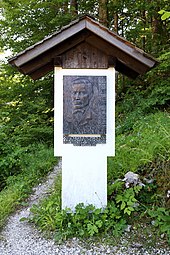Johann Georg Ramsauer
Johann Georg Ramsauer (born March 7, 1795 in Hallstatt ; † December 14, 1874 in Linz ) was a mining clerk from Hallstatt. In 1846 he discovered the Iron Age burial ground in Hallstatt and carried out the first excavations there.
Life
Ramsauer, born in Hallstatt in 1795 , entered the service of salt mining as a “manipulation pupil” at the age of 13 and rose quickly to the top : at the age of 36 he became a mountain master in Hallstatt. In November 1846 he finally succeeded in uncovering an unknown field of corpses by "opening a gravel pit".
Ramsauer's particular merit is the meticulous documentation of the finds, together with the miner Isidor Engl, who made sketches. In the following 17 years, 980 graves were opened and over 19,497 objects were recovered. As a scientific layman, however, Ramsauer was refused full recognition; in 1859, for example, his request to Emperor Franz Joseph I to have the excavation protocols printed was rejected.
Johann Georg Ramsauer was married three times and the father of 22 children. On November 5, 1863, he retired and moved to Linz, where he died in 1874.
effect
In the same year, the Swedish researcher Hans Hildebrand spoke of a “Hallstatt group” and soon afterwards the terms Hallstatt culture and time prevailed. Although Ramsauer thought the site was exhausted, more graves were uncovered by 1939. In 1994, the Vienna Natural History Museum resumed excavations with great success.
literature
- M. Pertlwieser - H. Zapfe: Ramsauer Johann Georg. In: Austrian Biographical Lexicon 1815–1950 (ÖBL). Volume 8, Verlag der Österreichischen Akademie der Wissenschaften, Vienna 1983, ISBN 3-7001-0187-2 , p. 409.
Web links
- Literature by and about Johann Georg Ramsauer in the catalog of the German National Library
- Godfather of an epoch in human history
- Günther Hattinger (lecture): Johann Georg Ramsauer <1795-1874> as a miner and his time as a miner
| personal data | |
|---|---|
| SURNAME | Ramsauer, Johann Georg |
| BRIEF DESCRIPTION | Austrian mine official (Hallstatt), prehistoric |
| DATE OF BIRTH | March 7, 1795 |
| PLACE OF BIRTH | Hallstatt |
| DATE OF DEATH | December 14, 1874 |
| Place of death | Linz |

